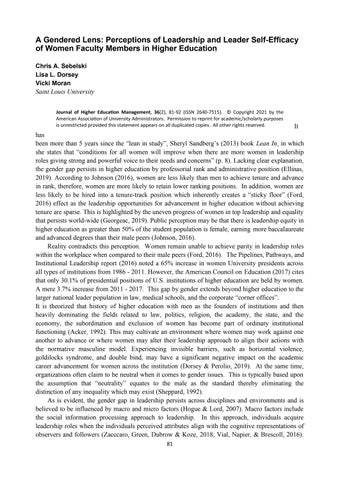A Gendered Lens: Perceptions of Leadership and Leader Self-Efficacy of Women Faculty Members in Higher Education Chris A. Sebelski Lisa L. Dorsey Vicki Moran
Saint Louis University Journal of Higher Education Management, 36(2), 81-92 (ISSN 2640-7515). © Copyright 2021 by the American Association of University Administrators. Permission to reprint for academic/scholarly purposes is unrestricted provided this statement appears on all duplicated copies. All other rights reserved.
It has been more than 5 years since the “lean in study”, Sheryl Sandberg’s (2013) book Lean In, in which she states that “conditions for all women will improve when there are more women in leadership roles giving strong and powerful voice to their needs and concerns” (p. 8). Lacking clear explanation, the gender gap persists in higher education by professorial rank and administrative position (Ellinas, 2019). According to Johnson (2016), women are less likely than men to achieve tenure and advance in rank, therefore, women are more likely to retain lower ranking positions. In addition, women are less likely to be hired into a tenure-track position which inherently creates a “sticky floor” (Ford, 2016) effect as the leadership opportunities for advancement in higher education without achieving tenure are sparse. This is highlighted by the uneven progress of women in top leadership and equality that persists world-wide (Georgeac, 2019). Public perception may be that there is leadership equity in higher education as greater than 50% of the student population is female, earning more baccalaureate and advanced degrees than their male peers (Johnson, 2016). Reality contradicts this perception. Women remain unable to achieve parity in leadership roles within the workplace when compared to their male peers (Ford, 2016). The Pipelines, Pathways, and Institutional Leadership report (2016) noted a 65% increase in women University presidents across all types of institutions from 1986 - 2011. However, the American Council on Education (2017) cites that only 30.1% of presidential positions of U.S. institutions of higher education are held by women. A mere 3.7% increase from 2011 - 2017. This gap by gender extends beyond higher education to the larger national leader population in law, medical schools, and the corporate “corner offices”. It is theorized that history of higher education with men as the founders of institutions and then heavily dominating the fields related to law, politics, religion, the academy, the state, and the economy, the subordination and exclusion of women has become part of ordinary institutional functioning (Acker, 1992). This may cultivate an environment where women may work against one another to advance or where women may alter their leadership approach to align their actions with the normative masculine model. Experiencing invisible barriers, such as horizontal violence, goldilocks syndrome, and double bind, may have a significant negative impact on the academic career advancement for women across the institution (Dorsey & Perolio, 2019). At the same time, organizations often claim to be neutral when it comes to gender issues. This is typically based upon the assumption that “neutrality” equates to the male as the standard thereby eliminating the distinction of any inequality which may exist (Sheppard, 1992). As is evident, the gender gap in leadership persists across disciplines and environments and is believed to be influenced by macro and micro factors (Hogue & Lord, 2007). Macro factors include the social information processing approach to leadership. In this approach, individuals acquire leadership roles when the individuals perceived attributes align with the cognitive representations of observers and followers (Zacccaro, Green, Dubrow & Koze, 2018; Vial, Napier, & Brescoll, 2016). 81




